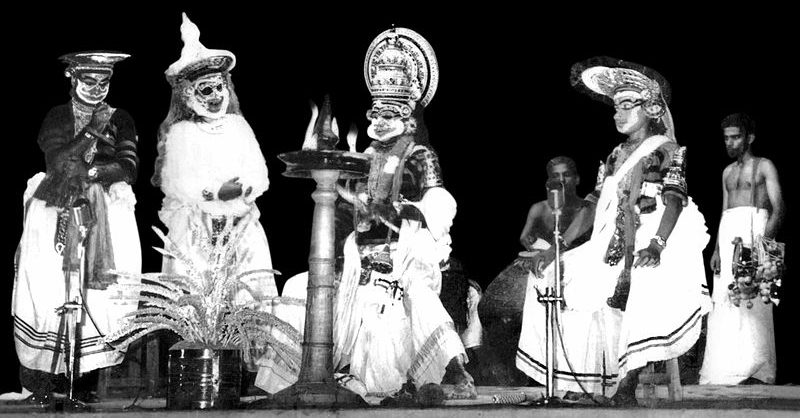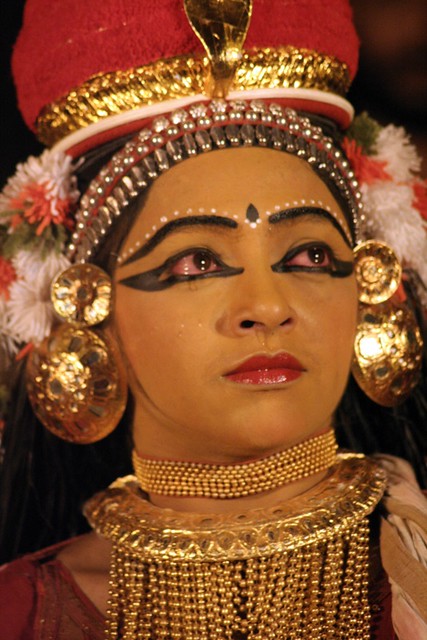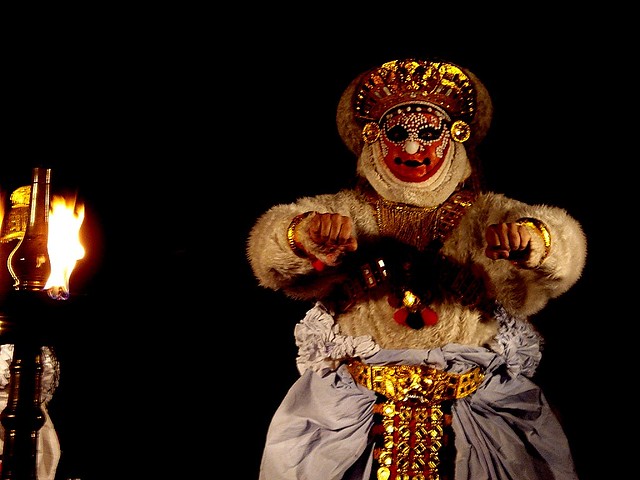By Debopriya Bhattacharya

Known to be India’s oldest living theatrical tradition, Kootiyattam, is the Sanskrit theatre which is practiced in the province of Kerala. A representative of ‘synthesis of Sanskrit classicism’ and reflection of the ‘local tradition of Kerala’ as UNESCO puts it, this theatrical tradition is as old as 2000 years. As quoted on UNESCO’s website, in the stylized and codified theatrical language of Kootiyattam, “netra abhinaya” (eye expression) and “hasta abhinaya” (the language of gestures) are prominent.”
The name Kootiyattam is identified as the combination of two words, ‘kooti’ meaning joined together and ‘attam’ meaning dance and an extended reference to acting. When put together, the word Kootiyattam means dancing together or acting together. Or in the words of Satya Chaitanya, “Kootiyattam is acting together in many different senses, one of which is that it is a form of theatre in which men and women act together on the stage.”
Traditionally performed in theatres called Kuttampalams, which are located in Hindu temples, Kootiyattam is known to have been restrictive in terms of giving access to performance which is largely owed to the sacred nature of this theatre form.

The performing team would act out a play which was selected from the works of a leading Sanskrit dramatist, Bhasa, who in fact was looked at as a role model by one of the most popular ancient playwrights, Kalidasa. A distinct feature of Kutiyattam is how the performances were not based on the full text of a Sanskrit play. Rather individual acts from the plays were selected and were treated as full-fledged plays in themselves, with the stage stretching over a period of several days.
Besides, Kutiyattam is known to be the only classical theatre form in which women have played a role throughout its history, an observation made by Coralie Casassas in her essay. Actresses who belonged to the nangyar caste enacted the female roles in the plays while keeping the rhythm with cymbals and eventually singing the Sanskrit poems, while male actors from the chakyar community played the main role.
However, it was noted that with the onset of the ritual period of Kootiyattam in the fourteenth century, when these plays were performed inside the Kuttampalams, women did not appear on the stage anymore. In fact, male actors of the chakyar community introduced techniques so as to enact the female characters, thereby limiting the role of nangyars (actresses playing female characters) to that of rhythmic accompaniment.
But, the erasure of the need for the actresses on the stage for Kootiyattam led to the development of the female soloist art in Kootiyattam tradition, known as Nangyar Kuttu. Actresses from the nangyar caste thus stopped performing female roles in Kootiyattam but rather worked on the development of this successful solo performance, sixteenth century onwards.
In the face of various changes that Kootiyattam went through, it experienced radical changes in the mid to late twentieth century when it was on the verge of declining. It was due to the efforts of Painkulam Rama Chakyar, who for the first time performed out of the temple in 1949, and that of Mani Madhava Chakyar, who performed for All-India Radio in the early 1950s that Kootiyattam was brought outside the rigid structures of the temple.
However, up till now, the Kootiyattam performers were done without women actors on the stage and it was only after the arrival of Kalamandalam Girija in 1971, that the scene changed.
As the first non-nangyar student of Kootiyattam, Girija not only broke through the caste barrier to which this art form was confined to but is also responsible for the “first revival ‘wave’ of women playing female characters” along with Kalamandalam Shailaja who joined KKM(Kerala Kalamandalam) in the year 1973 and Margi Sathi, in the year 1976.

In the year 1986, Girija became the first artistic female solo performer on a public stage in Chennai. It was this event that marked the revival of Nangyar Kuttu and consequently “opened a new field of creative freedom for the actress and thus sparked the second revival wave of female characters envisioned by women themselves” as discussed by Coralie Casassas.
Other than this, Girija’s contribution in terms of reinsertion of strong women characters in the Kootiyattam tradition and creation of new stories sure is an added effort for the revival of the dying tradition.
Besides, ever since the emancipation of Kootiyattam from the temple rituals, the performance has been restructured in a way to reach a wider audience, given how the question of the audience has always been one of importance for Kootiyattam. What was started by the efforts of their guru Painkulam Rama Chakyar is now being carried on forward by the Kootiyattam actresses.
While Kalamandalam Girija’s attempt at audience development is through pedagogy and transmitting the art to subsequent generations, the other way in which the audience is being reached out is through mass media. Promoting the art form through print media, film and television, and picking the best from each of Nangyar Kuttu and Koodiyattam to develop her own unique mix are some of Margi Sathi’s contributions to the revival of this art form. Even Casassas writes in her essay that “Margi Sathi, appearing at every function, has created the feminine presence of Kootiyattam across Kerala and been successful in seducing a large audience to become more interested in the form. She has helped recruit the younger generation to an art that was often considered too rigorous or boring.” Margi Sathi has become the modern icon of Koodiyattam.
New choreographies like ‘Chintavishtayaya Sita’ and ‘Mandodari’ by Usha Nangiar have further helped in redefining and creating awareness of a female identity on the Koodiyattam stages. Presentation of a revolutionary female point of view through female artists by expressing desires, emotions and troubles through their performances has been made possible because of the same.
Some notable contributions by both female and male creative artists in the past few decades have helped the tradition of Kootiyattam to adapt better to contemporary society. The constant and the conscious efforts of the artists are reflective in the form of how this 2000-year-old theatrical form is also recognized by UNESCO as ‘Masterpiece of the Oral and Intangible Heritage of Humanity’.

